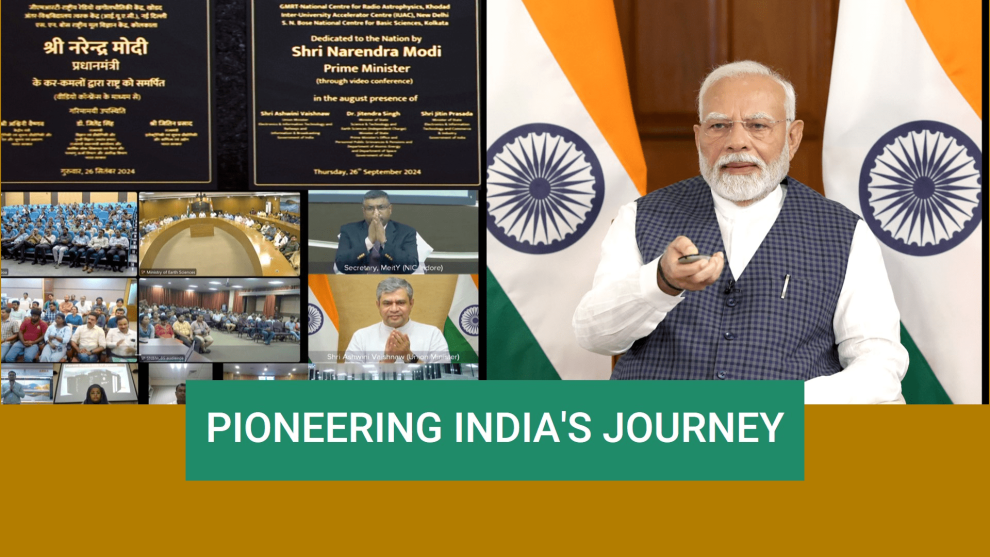On September 26, 2024, Prime Minister Shri Narendra Modi dedicated to the nation three PARAM Rudra Supercomputers worth around ₹130 crore via video conferencing. Developed indigenously under the National Supercomputing Mission (NSM), these supercomputers are set to transform scientific research across various domains, including weather and climate studies. This significant step towards self-reliance in computing signifies India’s commitment to advancing science and technology.
The Inauguration of High-Performance Computing (HPC) Systems
A Leap Forward for Weather and Climate Research
The inauguration of the PARAM Rudra Supercomputers coincided with the unveiling of two High-Performance Computing (HPC) systems named ‘Arka’ and ‘Arunika,’ tailored specifically for weather and climate research. The investment of ₹850 crore for these systems marks a monumental leap in India’s computational capabilities for meteorological applications.
Located at two pivotal sites, the Indian Institute of Tropical Meteorology (IITM) in Pune and the National Center for Medium Range Weather Forecast (NCMRWF) in Noida, these HPC systems will enhance the accuracy and efficiency of weather predictions.
A National Achievement
Addressing the occasion, Prime Minister Modi highlighted the monumental achievement represented by the PARAM Rudra Supercomputers, stating, “Today marks a huge achievement in the field of science and technology for India and is a reflection of the nation’s progress by prioritizing research and development.”
Key Benefits of PARAM Rudra Supercomputers
- Scientific Research: These supercomputers will aid advanced research in various fields, including physics, earth sciences, and cosmology.
- Disaster Management: Enhanced computing capabilities will improve forecasting and management of natural disasters.
- Economic Growth: The integration of high-performance computing into research can fuel economic development by driving innovation.
Prime Minister Modi’s Vision for India
Fostering a Culture of Innovation
Prime Minister Modi dedicated the PARAM Rudra Supercomputers to the youth of India, emphasizing the importance of making state-of-the-art technology accessible for the next generation of scientists. He stated, “These supercomputers will play a crucial role in making advanced research available to young scientists in the country.”
Self-Reliance Through Research
Highlighting the mantra of Atmanirbharta (self-reliance), Modi reiterated the government’s focus on strengthening the nation’s scientific infrastructure. He remarked, “India’s mantra is Atmanirbharta through research, Science for Self-Reliance,” citing campaigns like Digital India, Startup India, and Make In India.
The Role of Supercomputers in Research
Transforming Scientific Endeavors
With the PARAM Rudra Supercomputers, India aims to position itself as a leader in high-performance computing, directly enhancing the nation’s capability in various scientific fields.
Applications Across Disciplines
- Physics: The supercomputers will facilitate complex simulations and data analysis in various physics domains.
- Earth Sciences: Enhanced modeling capabilities will aid in geological studies, climate change research, and resource management.
- Cosmology: The supercomputers will enable researchers to analyze astronomical data and explore the universe’s mysteries.
A Global Perspective
Historically, supercomputers have been the domain of a select few nations. With the establishment of the National Supercomputing Mission in 2015, India is now competing with global supercomputer leaders, striving to expand its capabilities in quantum computing as well.
The Significance of Weather and Climate Research
Addressing Climate Challenges
The HPC systems ‘Arka’ and ‘Arunika’ are tailored to provide high-resolution weather models. They will significantly enhance the accuracy and lead time of predictions related to:
- Tropical cyclones
- Heavy precipitation
- Thunderstorms
- Hailstorms
- Heatwaves
- Droughts
This capacity for detailed weather forecasting will allow for better preparation and response to climate-related challenges.
Aiding Farmers and Fishermen
Prime Minister Modi emphasized the practical implications of these supercomputers for everyday citizens, stating, “Supercomputers will ensure that even the smallest farmer has access to the world’s best knowledge.”
- Farmers: They will gain insights to make informed decisions about their crops.
- Fishermen: Enhanced weather predictions will reduce risks associated with sea ventures.
The Future of Science and Technology in India
Expanding the Frontiers of Knowledge
India’s journey from supercomputers to quantum computing reflects the nation’s grand vision for scientific progress. The Prime Minister highlighted the government’s commitment to fostering innovation and research across various sectors.
National Pride and Global Competitiveness
Prime Minister Modi expressed that the ability to build supercomputers is a matter of national pride. He asserted, “The benefits will trickle down to the everyday lives of common citizens,” aiming to ensure that technology enhances quality of life for all.
Conclusion: A Call to Young Researchers
In conclusion, the Prime Minister encouraged young researchers to leverage these advanced facilities, exploring new domains in science and technology. He reiterated that the true purpose of scientific advancement lies in fulfilling the aspirations of the common man, ensuring that innovation serves the broader community.
Additional Information
- Background of PARAM Rudra Supercomputers: The PARAM Rudra Supercomputers have been developed under the NSM and are stationed in Pune, Delhi, and Kolkata. Each site has specific research focuses, enhancing capabilities in various scientific fields.
- Significance of High-Performance Computing: The HPC systems represent a significant investment in India’s technological future, enhancing the nation’s ability to address complex scientific questions and foster innovation.
With Inputs from Press Information Bureau.












Add Comment